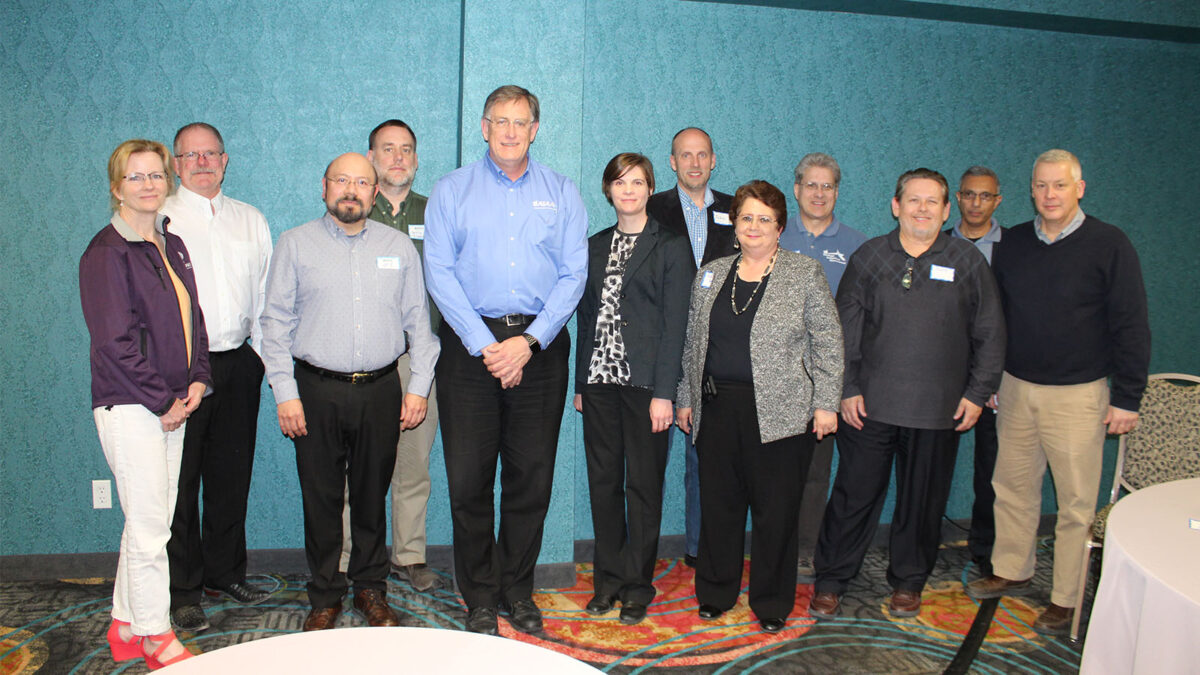- 2018 AIAA Lawrence Sperry Award Winner
- Newly Elected Board of Trustee Members and Treasurer
- Clarkson University Wins 22nd Annual Student Design/Build/Fly Competition
- 2018 TARC National Finals
- 2018 AIAA Regional Student Conferences
- Call for Papers: Special Issue on “Multi-Core Architectures in Avionic Systems”
- AIAA Orange County Section Recent STEM and Outreach Activities
- AIAA Sydney Section Commemorates the 100th Anniversary of the Fall of the Red Baron
- AIAA New England Section Hosts Major STEM Event
Bulletin
Member News 2018 AIAA Lawrence Sperry Award Winner
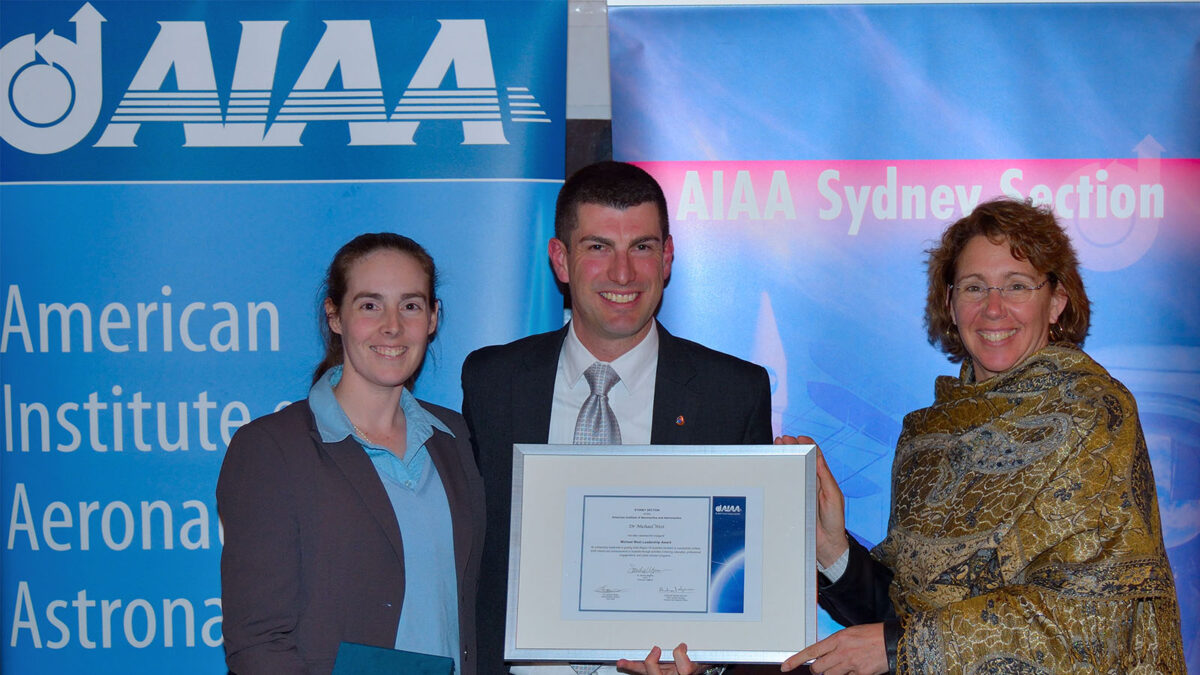
By Michele McDonald, AIAA Communications
With a grandmother who flew Tiger Moth biplanes in Africa after World War II and a grandfather who was an electrical engineer, it makes sense that Michael West became an aerospace engineer.
“They inspired me with stories from their careers and their travels around the world,” said Dr. West, 2018 AIAA Lawrence Sperry Award winner. “As a child, I always enjoyed solving puzzles and trying to design things. Even though I was interested in becoming a lawyer or an architect, it is no surprise that I got drawn into engineering.”
And space held a fascination long before university studies.
“One of my earliest childhood memories is watching Halley’s Comet from the front veranda of the family home in a small country town in regional Australia,” he said. “Being more than 400 kilometres from any major cities meant that the view was spectacular.”
Dr. West knows first-hand how life-changing STEM activities can be for students. His high school science teacher encouraged him to become involved in astronomy and rocketry.
“When I was 14, I won a science competition with two school friends that involved designing an experiment for the Space Shuttle. The prize was an expenses-paid trip to the United States to visit the Johnson and Kennedy Space Centers and see a space shuttle launch. We got a behind-the-scenes tour of the NASA facilities and then saw John Glenn launch back into space on the STS-95 shuttle mission. I was already interested in aerospace, but from that point on I was completely hooked.”
Also, while in high school, Dr. West launched two experiments aboard sounding rockets at the Woomera Rocket Range in central Australia. The rockets pulled about 70 G and reached Mach 2 just after liftoff.
“During the second launch cycle, I was allowed to stand in the bunker under the launch pad and press the button to initiate the launch,” he said. “The sensation as the enormous concrete bunker shook is something I will never forget.”
As a teenager, Dr. West met shuttle astronauts Pamela Melroy and Scott Parazynski, and Apollo 17 astronaut Harrison Schmidt. “Hearing their stories and seeing such accomplished, intelligent and humble people left a real impression on me,” he said.
Dr. West wants others to have similar experiences and has worked on STEM outreach to students and the general public. He has organized workshops for school science teachers and regularly participates in outreach activities at air shows, science fairs, school fetes, and other community events.
After being selected as a state finalist in the 2006 Young Australian of the Year Awards, Dr. West served as an Australia Day Ambassador for five years, visiting regional communities and sharing his experiences and passion for space exploration, science, engineering, and innovation.
“I am proof that these activities work and that they can motivate someone for a lifetime,” he said. “Because of these experiences, space exploration is my passion. Every project I have worked on since has needed to have a space component to it, otherwise I quickly lose interest.”
West gravitates to engineering challenges.
Dr. West’s nominators cited his Ph.D. work at the Australian National University (ANU) as providing valuable outcomes to the aerospace industry. He conducted the first extensive space simulation tests of the Helicon Double Layer Thruster (HDLT) prototype – a new spacecraft electric propulsion system. Fellow engineers can identify with the hours spent in the lab, testing different approaches and designs and failing often.
Then came Dr. West’s eureka moment about a year before finishing his thesis. “While playing around with the power and other settings for the HDLT prototype, something strange happened and at first I thought I had damaged the apparatus as a bright glow and arcing appeared inside the vacuum chamber,” he described. “After turning everything off, taking a breath, restarting the system and trying the settings again, I was able to recreate the effect and the bright glow in the HDLT prototype’s plasma source. Later it became clear that I had be able to reproduce a new high density ‘blue’ mode when operating the HDLT prototype in xenon.”
This “blue” mode had only been observed once before, Dr. West explained, when the HDLT prototype was tested at the European Space Research and Technology Centre (ESTEC) several years earlier. He then spent the next few months characterizing this “blue” mode. The findings became an important part of his Ph.D. thesis and led to several journal publications with ANU colleagues.
Dr. West’s Sperry award nominators noted that the outcomes of his Ph.D. work provided valuable insights and experience for the research team as they developed ANU’s new $4 million WOMBAT XL Space Simulation Facility – the largest thermal-vacuum facility of its type in the Southern Hemisphere.
Dr. West has worked in research, academia and government, learning from each. “My time in academia and as a researcher taught me valuable critical thinking skills and how to break out a complex problem into its constituent parts and tackle it in a systematic way. Working in government has reinforced the importance of the soft skills – conveying complex information in easy to understand ways, writing clearly and with influence, engaging with diverse stakeholders to get an outcome despite competing goals, priorities and pressures.”
When he was 17 and starting undergraduate studies in aerospace engineering, Dr. West joined AIAA. He first became a member for the book discounts, but continued for the career development.
“Being involved with AIAA has expanded my knowledge, helped build my professional network and provided valuable opportunities to develop my leadership and management skills,” he said. “The real career value is in the second order benefits. It is the access to the aerospace influencers – those who are shaping the future of the industry. It is the friends I have made. It is the like-minded individuals who I have interacted and worked with and who are such an inspiration. AIAA is the link to all the amazing things happening in the aerospace industry.”
As a passionate volunteer, Dr. West reactivated the dormant AIAA Sydney Section and expanded its activities into the Canberra region in 2007. While section chair between 2009–2015, he was instrumental in initiating and implementing career development activities for hundreds of professionals and students, including multiple nationwide lecture tours.
“With natural leadership ability, Michael competently managed a large team of volunteers, spread across two cities and four universities,” according to nomination documents. “During Michael’s tenure, AIAA membership in Australia grew considerably (now over 500+) and the AIAA is the nation’s most active aerospace organization.”
West is honored to have received the Sperry award.
“As an Australian, to be recognised by a prestigious international organisation such as AIAA is really special,” he wrote. “Looking at the list of previous winners is really humbling as well. Many of the past recipients are people that I have read about, whose careers and achievements have amazed and inspired me.”
AIAA Leadership Newly Elected Board of Trustee Members and Treasurer
In May the AIAA Council of Directors elected a new Treasurer and four new Board of Trustees members. Because the Treasurer was an existing Board member, a vacancy was created, which was also filled.
The new Treasurer is Annalisa Weigel. New Board members are Missy Cummings, John Dowdle, R. Steven Justice, and David Throckmorton.
AIAA Program Clarkson University Wins 22nd Annual Student Design/Build/Fly Competition
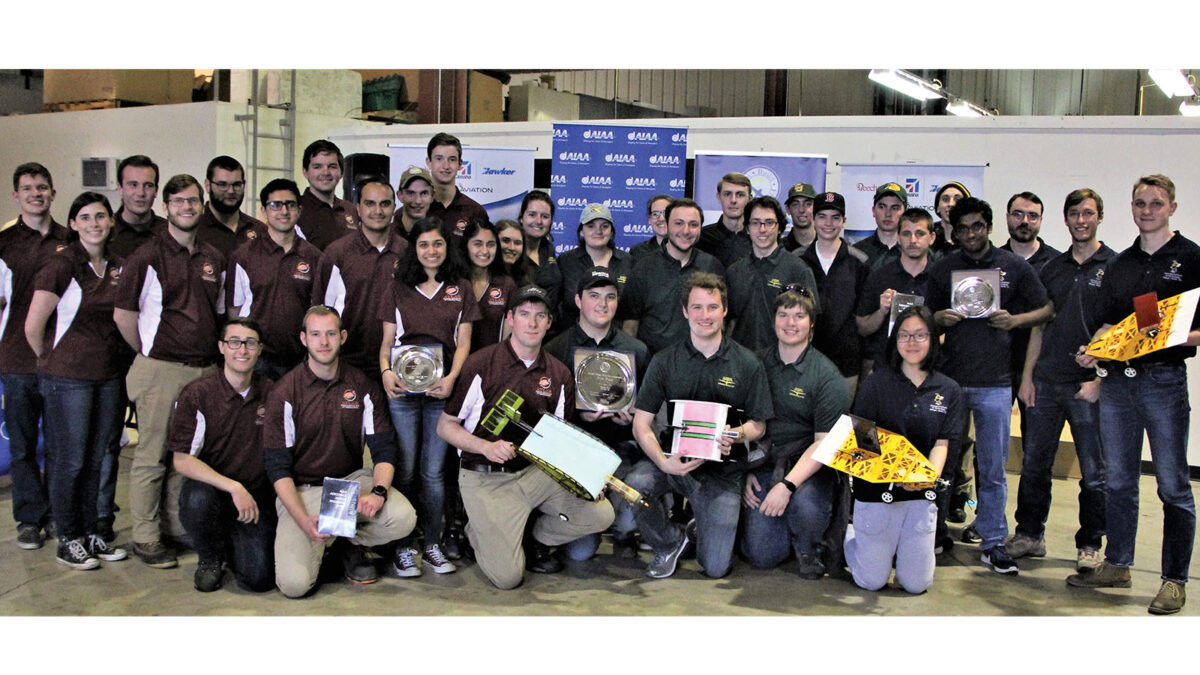
The 2017–2018 Textron Aviation/Raytheon Missile Systems/AIAA Foundation Student Design/Build/Fly (DBF) Competition was held 19–22 April, at the Cessna Pawnee East Field in Wichita, KS. The event included 77 teams and 720 students from 16 counties—a new DBF record! The students had to design a Regional and Business Aircraft. The aircraft was required to fly a combination of passengers and payload as well as demonstrate the ability to conduct LRU replacement in the field. Of the 245 official flight attempts, 153 resulted in a successful score with 50 teams achieving at least one successful flight score and 24 teams successfully completed all three missions. The Clarkson University team won the event by a small margin with Virginia Polytechnic Institute and State University in second place, and Georgia Institute of Technology finishing in third place. The Best Paper Award, sponsored by the Design Engineering Technical Committee, went to the University of Southern California.
Official results and rankings for all participants are available on the DBF website (aiaadbf.org). Thank you to all of our Premier, Gold, Silver, and Bronze sponsors (aiaadbf.org/Sponsors) who help us inspire the next generation. A special thanks to the volunteers who helped make this year a success!
STEM Activities 2018 TARC National Finals
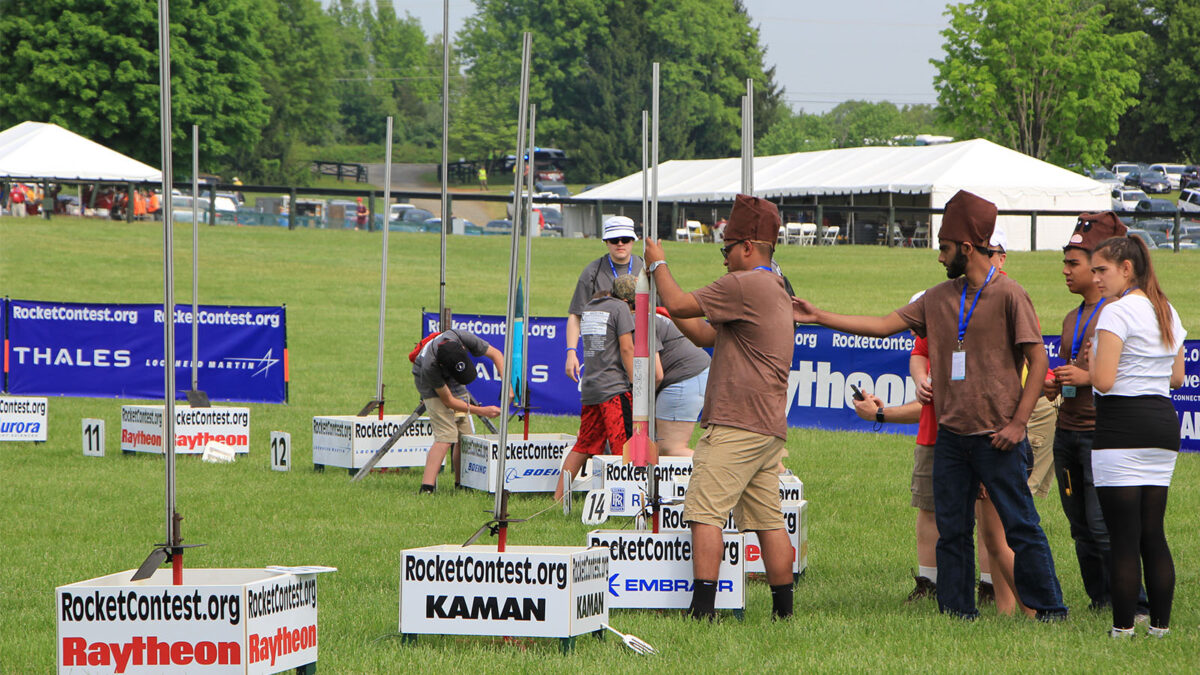
By Michele McDonald, AIAA Communications
The energy from high school and middle school teams nearly outpaced their rockets on 12 May as they competed in the Team America Rocketry Challenge (TARC) on a grassy field in Virginia. About 100 teams from across the country competed in the TARC national finals for the privilege of going to London for the international competition. Creekview High School from Canton, Georgia, took the top spot. All the results can be found at rocketcontest.org/competition-results/2018-results. Teams traveled from California, Texas, Iowa, Ohio, Washington, New York, and Colorado, among other states.
Rocketry helps introduce teens and preteens to engineering, said AIAA President John Langford, as he took a break from flying a drone near the launchpad zone. “I think it’s really critical to have programs like the Rocketry Challenge,” he said. “It may not have occurred to a lot of these kids to go into aerospace. You don’t know who you’re going to reach. This may change the lives of some and for the rest, they’ll have a lot of fun.”
There’s more to the Rocketry Challenge than action on the launchpads, Langford, founder and CEO of Aurora Flight Sciences, said, adding the teams need AIAA members as mentors. “The kids are so fun to watch as they collaborate and work through problems,” he said. “The best part is watching them prep.”
Arianna, a member of Team Rocket from Newark Memorial High School in California, said that the challenge “definitely pushed me in the direction of STEM.” She added that she’s heading to UCLA in the fall where she plans to join their rocketry club.
Student Conferences 2018 AIAA Regional Student Conferences
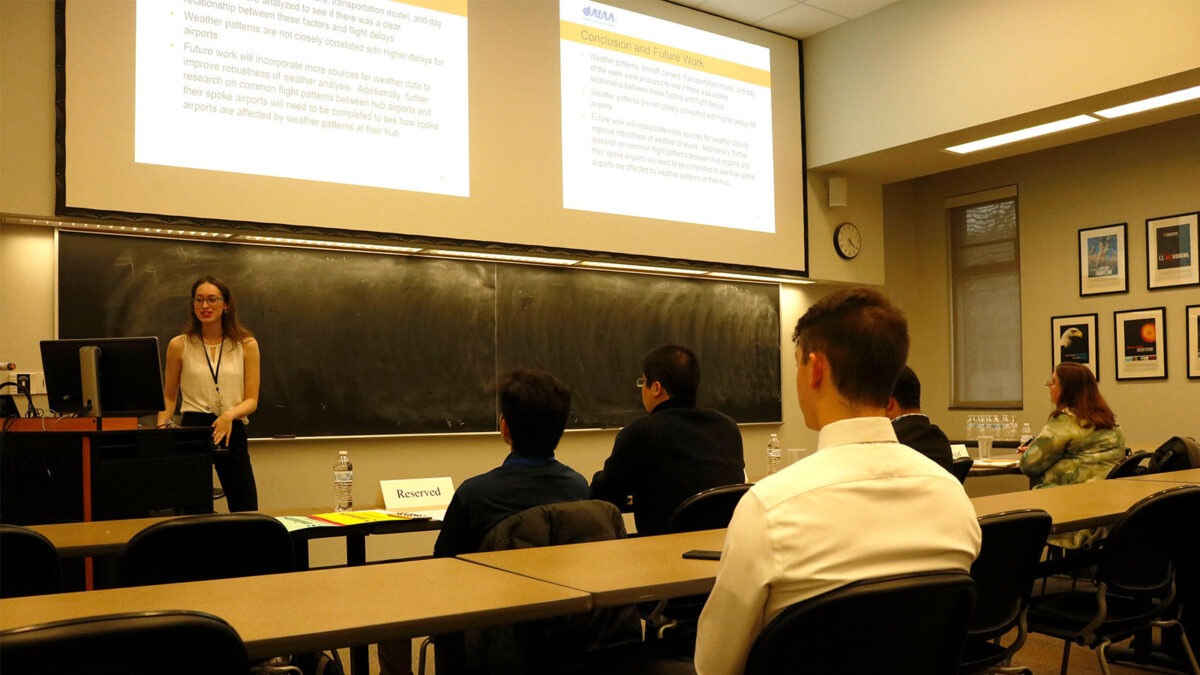
AIAA sponsors student conferences in each AIAA Region for student members at both the undergraduate and graduate levels. Students from regional schools have the opportunity to present their research on aerospace topics in a formal presentation. The students’ formal presentations are judged on technical content and clarity of communication by professional members from industry. In addition to the competition, the conferences provide a venue for students to share AIAA experiences, participate in social activities, connect with industry professionals, and exchange ideas about current topics in aerospace engineering.
In early 2018, the Lockheed Martin Corporation provided a generous donation to the AIAA Foundation to support the Regional Student Conferences and the International Student Conference. Funding was provided to the student branch to organize the conference as well as provide prize money for the three categories supported by the AIAA Foundation. The first-place winners in each category (listed below) will be invited to attend and present their papers at the AIAA Foundation International Student Conference that will be held in conjunction with the 2019 AIAA SciTech Forum in San Diego, California, 7–11 January.
Undergraduate Category Winners
Region I: Assessing the Transient Gust Response of a Representative Ship Air wake using Proper Orthogonal Decomposition, Christopher G. Cantillo, United States Naval Academy
Region II: Design for Multi-Axis Fused Filament Fabrication with Continuous Fiber Reinforcement: Unmanned Aerial Vehicle Applications, Paul G. Sinkez and Wout De Backer, University of South Carolina
Region III: Development of an Emergency Response UAV, Mitchell Lozier and Cameron Sickbert, Rose-Hulman Institute of Technology
Region IV: Application of Computational Intelligence for Command & Control of Unmanned Air Systems, Hannah C. Lehman, Texas A&M University
Region V: The Impact of a Notched Leading Edge on Performance and Noise Signature of Unmanned Aerial Vehicle Propellers, Anna C. Demoret and Charles F. Wisniewski, United States Air Force Academy
Region VI: Stability and Control Derivative Estimation for the Bell-Shaped Lift Distribution, Loren J. Newton, University of California, Berkeley
Masters Category Winners
Region I: Characterization of a Hybrid (Steel-Composite) Gear with Various Composite Materials and Layups, Sean M. Gauntt and Robert L. Campbell, Pennsylvania State University
Region II: Characterization of near-Muzzle Ballistic Flow Fields using High-Speed Shadowgraphy, Matthew J. Schwartz and John D. Schmisseur, University of Tennessee Space Institute
Region III: Investigation of Nanosecond-Scale Plasma Discharges at Atmospheric Pressure Using Time-Resolved Imaging, Paul W. Stockett, Ravichandra R. Jagannath, and Sally P.M. Banc, Purdue University
Region IV: Comparison of Linear and Nonlinear Dynamics of a Virtual Telescope, Richard Adcock, University of New Mexico
Region V: Multi-Mode Micropropulsion Systems Enabling Swarm Technology, Matt Klosterman and Shannan Withrow, Missouri University of Science and Technology
Region VI: Velocity Measurements of Projectiles Propelled by Underexpanded Supersonic Jets, Fin van Donkelaar, University of Washington
Team Category Winners
Region I: Stereoscopic Mixed Reality in Unmanned Aerial Vehicle Search and Rescue, Saimouli Katragadda, Xincheng Li, and Benedict Mondal, University of Maryland
Region II: The Road to the Karman Line: Development of Liquid-Fueled Propulsion and Flight-Control Systems for Suborbital Launch Vehicles, Suraj Buddhavarapu, Trenton Charlson, Neel Dutta, Akhil Gupta, Gabriel Rizzo, Shrivathsav Seshan, and Ben Zabback, Georgia Institute of Technology
Region III: Liquid Water Micropropulsion System for Small Satellites, Steven M. Pugia, Ryan J. Clay, Matthew F. Fuehne, Margaret N. Linker, Noah C. Franks, Benjamin J. Davis, and Katherine I. Fowee, Purdue University
Region IV: Payload Design and Development for Orbital Structural Health Monitoring, Luke Byrom, Carl Bancroft, Douglas MacNinch, Shane Mckinney, Daniel Pancheco, Michael Underwood, and Arjun Tandon, New Mexico Institute of Mining and Technology
Region V: Preliminary Engine Cycle Design for Commercial Supersonic Transport, Martin Gleason, Igor Gertsman, Dan Inman, Derek McGuckin, Brennen Poole, Jisung Yi, and Peter Yoon, United States Air Force Academy
Region VI: Spray Cone Formation from Pintle-Type Injector Systems in Liquid Rocket Engines, James Blakely, Johann Freeberg, and Jacob Hogge, University of Southern California
Publications Information Call for Papers: Special Issue on “Multi-Core Architectures in Avionic Systems”
Journal of Aerospace Information Systems (JAIS) is devoted to the applied science and engineering of aerospace computing, information, and communication. Original archival research papers are sought that include significant scientific and technical knowledge and concepts. In particular, articles are sought that demonstrate the application of recent research in computing, information, and communications technology to a wide range of practical aerospace problems in the analysis and design of vehicles, onboard avionics, ground-based processing and control systems, flight simulation, and air transportation systems.
The journal intends to publish a special issue on multi-core architectures in avionics systems. Guidelines for preparing your manuscript can be found in the full Call for Papers on the JAIS page in Aerospace Research Central (arc.aiaa.org). The journal website is arc.aiaa.org/loi/jais.
Background: With the growth of the cyber layer in aircraft and the paradigm shift from federated and distributed on-board systems architectures to Integrated Modular Avionics (IMA), there is an increasing demand on higher throughput computing architectures. This is further elevated with optimization efforts to reduce the total number of high-speed computers within an airplane to comply with space, weight, and power (SWAP) requirements and to achieve a better maintainability. Well-known platforms will not be able to satisfy the ever-increasing requirements on SWAP and processing performance. Thus, for new functionality higher performing systems must be implemented using alternative and emerging architectures. Multi-core technology, now being state of the art in standard Information & Communications Technology (ICT), seems to be the most promising path to improve computational capabilities in avionics systems. However, there are still many challenges associated with transition to multi-core architectures.
Topics of interest to this special issue aim toward a focused forum to disseminate the latest research about multi-core architectures in avionics systems. Original research papers are sought in, but not exclusive to, the following topics:
• Multi-core processors for avionics applications
• Certification of multi-core based platforms
• Model-driven development for multi-core systems
• Parallelization of multi-core applications
• ARINC 653 and multi-core
• Worst Case Execution Time (WCET) in multi-core systems
• Virtualization for multi-core avionics systems
• Quality of service (QoS) in multi-core architectures
• Mixed-criticality on multi-core architectures
• Methods and tools related to the usage of multi-core in avionics
Deadline: Submissions are due by 21 December 2018.
Publication Date: The anticipated publication date of the special issue is April 2019.
Guest Editors: Umut Durak, German Aerospace Center (DLR), umut.durak@dlr.de; Falco Bapp, Karlsruhe Institute of Technology (KIT), falco.bapp@kit.edu.
Section News AIAA Orange County Section Recent STEM and Outreach Activities

By Dr. Amir S. Gohardani, Chair, AIAA Orange County Section
The AIAA Orange County (OC) Section in Southern California has recently taken part in several STEM activities. These activities have primarily been spearheaded by the section’s Education Officer Jann Koepke and the section’s Member-at-Large Officer and Team America Rocketry Challenge (TARC) mentor, Bob Koepke.
Most recently, 11 TARC rocket launches were recorded and the Koepkes also attended a launch event at Holtville Airport for the NASA Student Launch team to test their student rockets. In close collaboration with the Mendez Amateur Radio Club to teach basic electronics and demo Amateur Radio, the Koepkes regularly engage with TARC teams in Orange County, and they recently also held a TARC Qualification Launch for the Starbase TARC teams at Los Alamitos joint military base. The commitment of the Koepkes to support the youth in Orange County is admirable and on 17 February, Jann Koepke was recognized with the Orange County Engineering Council (OCEC) STEM Service Award during the OCEC Annual Banquet.
In a parallel outreach effort, AIAA OC’s Membership Officer Bob Welge and Secretary Gene Justin represented the section at the Boeing E-Week event on 22 February 2018.
Section News AIAA Sydney Section Commemorates the 100th Anniversary of the Fall of the Red Baron
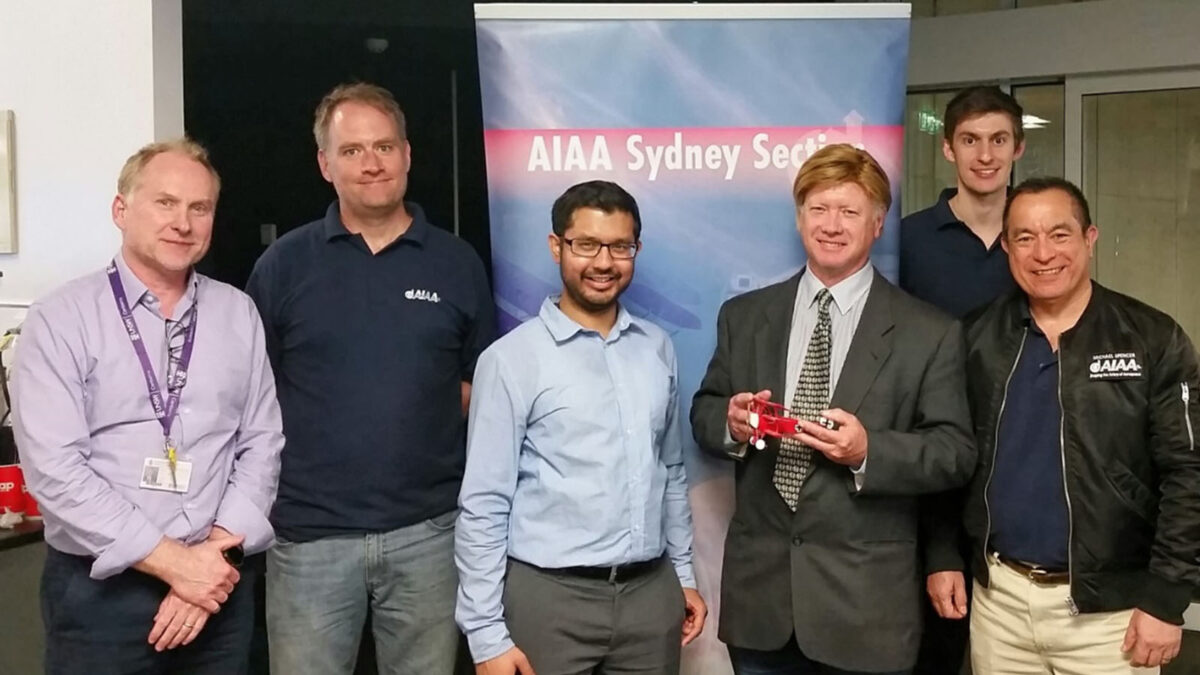
By Michael Spencer, AIAA Sydney Section
German Imperial pilot Baron Manfred von Richthofen was killed in air combat on 21 April 1918. He was unequalled in having shot down 80 enemy aircraft in aerial combat during World War I to become the most celebrated Ace of Aces in the early history of air combat. The British called him the “Red Baron”; the French scorned him as the “le diable rouge (Red Devil)”; he called himself the “Red Battle Flyer.” To commemorate this 100th anniversary of the death of the Red Baron, the AIAA Sydney Section arranged a public event and invited Dr. Thomas Faunce, Australian National University professor of law and medicine, and military aviation historian, to give a lecture that would lead the public through an evidence-based critical analysis of the likely contributing factors and catastrophic decisions leading up to his death and identify who fired that one fatal bullet.
On 21 April 1918, Richthofen pursued a Royal Flying Corps Sopwith Camel low over enemy-controlled territory, breaking one of his fundamental air combat maxims, and was fatally wounded. Richthofen managed to execute a controlled crash landing, on Australian-held battleground, before dying in the cockpit. Australian soldiers were quick to attend the crash site and seek to recover Richthofen.
Although Captain Arthur “Roy” Brown (in a pursuing aircraft) was originally credited with the fatal shot, later medical forensic analyses of the wound ballistics have indicated that Richthofen was struck in the chest by groundfire and not from an airborne shooter. Australia’s Official War Historian, Charles Bean, has gathered eyewitness accounts from the battlefield that indicate it was most probable that Sergeant Cedric Popkin, an Australian Vickers machine gunner in the trenches, had fired the fatal shot that brought down the Red Baron (Bean, C. 1941. First World War Official Histories, Vol V – The Australian Imperial Force in France during the Main German Offensive, 1918. Appendix 4 – The Death of Richthofen. Online at www.awm.gov.au/collection/C1416782).
Richthofen was buried in a military cemetery in France, with full military honours, by members of No 3 Squadron, Australian Flying Corps. A British pilot flew solo over the German air base of 11 Jasta to air drop a message to respectfully inform them of the death of their celebrated commander.
